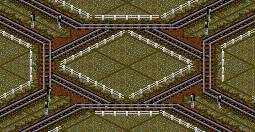
Part 4: Guide to Using Transport
Many of the ideas presented on this page have been "borrowed" from Chris Doherty's TT Railway Guide. I've put together a saved game demonstrating the ideas on this page; see the Download section for details.
Transport Tycoon is heavily biased towards trains. As such, trains are the most flexible and best all-around type of transport to use. Road vehicles, aircraft, and ships tend to be better for specialized purposes while trains are best for everything else.
No-brainer train line
In the beginning, it is often better to keep things simple. Don't build complicated train networks until later in the game when you can afford it. Also, early in the game, cities are smaller and industries put out less raw materials, so there isn't as much to cargo to ship. Later, when coal mines start spitting out over 1,000 tons per month, you'll need to build those fancy-shmancy train networks.
Here's how to build a simple train line:
Slightly more complex train line
If you want to have two trains on one line, you'll have to use signals and larger stations. Build 2x5 stations. Merge the two rails from the station into one (use two-way signals). Lay a single train line for several squares, and then insert a "passing lane". This means that the line splits into two for a short ways, and then merges back into one line. Use two-ways signals at both merges. Make sure the passing land is long enough to accommodate the longest possible train (five squares).
This is the layout that the AI uses with longer train lines. It is certainly not the best, however. Only two (maybe three is you're lucky) trains can use it. The two trains must pass at the passing lanes, which means one may have to wait several days for the other to come by. So, this is not a very efficient system. It is good early in the game when money is tight. Once you have money to burn, however, it is better to use the next layout.
Double lines
Passing lanes are not very efficient. Instead, it is better to have two parallel tracks connecting stations. Each track will be one way. Northbound trains (or whatever) will run on the right (or left if you're British) side, and southbound trains will run on the left. Both lines are separate, so trains won't have to stop to let others pass. To coerce the trains into following this pattern, you'll have to use one-way signals. The regular version of TT doesn't support one-way signals, so this layout isn't possible. To build a one-way signal, build a two-way signal and then click on it. It should now face one direction only. Click again to make it face the other direction, and click a third time to turn it back into a two-way signal.
With double lines, you can have more than two stations on a line. In fact, you can have all of your stations interconnected with double lines and intersections. For this to work, however, the layout will to be tweaked to perfection. The AI that controls the trains isn't very intelligent, so it can be fooled by some layouts. Trains may travel down the wrong line and may become lost, traveling in circles forever until you intervene. You'll have to keep an eye on your trains. If any train starts to lose money, check on it immediately.
Junctions
Double lines require more sophisticated junctions in order to keep the traffic flowing. If three or four double lines meet in one spot, a roundabout can be used:

| This arrangement can handle high volumes of traffic. It is simple, inexpensive to build, doesn't take up much space, and doesn't require bridges. However, bottlenecks can form because only one train can enter the roundabout at a time. |
For really heavy traffic, cloverleafs might work better. However, any type of cloverleaf will require one line to cross over another. This can slow down trains as they climb the slope on to the bridge. However, since there are no intersections, just mergers and branches, cloverleafs are very efficient.
Branches
When you have a station or line branching off from a main trunk line, you can use this junction.
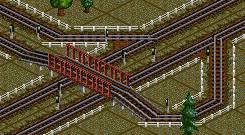
| This type of junction is very efficient and can handle lots of traffic. However, since there is a bridge, the trains will have to slow down to climb the slope. |
Stations
The tricky part of using double lines is designing your stations. They must be wide enough to accommodate the traffic and the tracks leading up to them have to be efficient.
One simple solution is this...
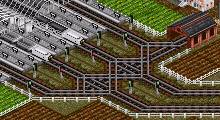
| The double line merges with the station at one end. A depot is attached to the intersection. Two-way signals are placed on each line heading into the station, and one-way signals regulate traffic on the double line. |
This type of station is simple, easy to implement, inexpensive, and doesn't take up much space. It works fairly well if traffic is light (two to four trains using the line). However, it is not very efficient because only one train can enter or leave the station or depot at a time. If a train breaks down while entering the station, all other trains are forced to sit and wait until it starts moving again. Also, bottlenecks can occur if more than four trains try to use the station at once.
Pass-Through Station
(aka "Ro-Ro Stations")
With high volume traffic, more efficient stations are necessary. The "pass- through station" is probably the most efficient type of station possible in TTD. Trains enter from one side, load or unload their cargo, and leave from the other end.
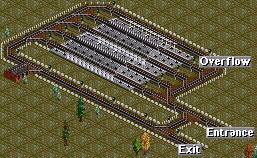
| Trains enter and pick an available slot in the station. If all four slots are occupied, the train uses the overflow ramp that loops around the station. The depot is located at a section of track that all trains will pass through. Two-way signals must be placed in front of the station so the trains will pick an available slot. All other rails need one-way signals to make sure the trains travel in the right direction. |
Variations on the pass-through station can help improve its efficiency. I'll leave it up to you to experiment to see what kind of layout works best for your particular game.
The major cause of bottlenecks at stations and intersections are breakdowns. When a train break downs, it stops for five days. Any other trains that are behind it are also stopped for five days. This may not seem like a big deal, but if this happens frequently, it can add up to lots of bottlenecks and reduced profits.
One solution is "mandatory servicing". Before a train enters a station or busy intersection, it is diverted to a depot for servicing. This restores its maximum reliability and reduces the risk of a breakdown.
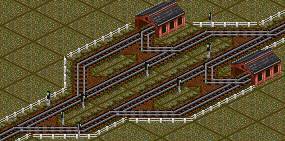
| This odd-looking setup is the most efficient type of mandatory servicing. The one-way signals prevent the trains from passing straight through; they have to turn off and enter the depot. The tracks that bypass the depots are required to overcome a bug in TTD. |
Road vehicles are only useful in some situations. In general it is best to use trains except when transporting low volumes of cargo. Below are some practical applications of road vehicles.
Connecting two small towns
Small towns in TT usually grow very slowly if left alone. If you provide good passenger services to that town, however, its population may explode. For small towns (under 500 people), it isn't economically feasible to build a train line. However, since road vehicles are inexpensive to build and maintain, you can connect two small towns and still break even or even make a small profit. In this kind of situation, you are more interested in boosting the town's population, not making a fortune.
Build two bus stations in the center of the towns and build a connecting road. Construct depots near each town (not necessarily next to the stations) and possibly between them if they are far apart. Buy the road vehicles (how many depends on how far apart the towns are), and relax. Come back in a few years and the towns should be growing. After 5 to 10 years or so the towns should have a commercial district (denoted by the sidewalks). After 10 to 15 years the town should have a population over 1,000 with a couple office buildings. After 15 years, the commercial district should be larger. At this point the bus stations will be overloaded with passengers. Replace the buses with a train, and the money will start to roll in.
This won't work for towns in a desert or above the snow line. For these towns you also need food and/or water, something that usually isn't available early in the game.
City bus line
A variation of the above strategy is to build two or more bus stations in one larger town (500-1,000 people). The town should grow even faster. The AI likes to build several bus stations in one town, and often they are profitable because the towns grow quickly. Compare towns with several bus stations to those with one or none at all. After several years there will probably be a noticeable difference in population.
Low production industries
Road vehicles work fairly well for connecting industries that have a lower than normal production rate. Often there isn't enough cargo for trains to make a profit, but road vehicles will work nicely. Don't connect industries with road vehicles if they are more than two screens apart. Also, don't build too many trucks on one line -- you'll have traffic jams at the loading station. If a bad jam does occur, open up the trucks' windows and hit the U-turn button. This should cause the jam to break up.
Aircraft are very useful for specialized services. Their advantages are their speed and little need for infrastructure. Their disadvantages are the high costs of making room for airports, their high maintenance costs, and their tendency to break down.
Metropolitan passenger services
The best use for aircraft is to move large volumes of passengers and mail quickly between distant towns. One flight of a full high capacity plane can reap thousands in profits.
For very distant towns, the supersonic aircraft (Concorde, Yate Haugan, and Darwin 1000) are the best bet. Their capacity is limited, but their speed (1,440 mph) is twice that of most other aircraft. Because of their high speed, they can transfer more passengers than slower but larger aircraft in the same amount of time. Unfortunately, supersonic aircraft are very expensive to buy and maintain. Also, if they suffer a breakdown, their speed will drop to just a couple hundred mph (the same speed that a regular plane will travel at during a breakdown). However, despite the cost and risk of breakdowns, these aircraft are certainly very profitable and worth using, as long as you have two large towns with room for airports.
On many occasions my airports have been inundated by passengers. You can only assign so many aircraft to a single airport before serious bottlenecks occur. A way to reduce the sheer volume of waiting (and probably disgruntled) passengers at the airport is to attach another station next to it. Building a train station next to the airport is a great way to bring in some extra money. Bus stops and truck stations (for mail) can be useful if there is no room for trains.
It is usually best to use Full Load orders for aircraft. However, this can cause trouble if a town produces much more passengers than mail. The planes may fill up with passengers, but not with mail. So, they will sit idle for months waiting for mail. Meanwhile, droves of disgruntled passengers will continue to descend upon the airport. Therefore, it is usually a good idea to keep an eye on your airports to make sure the passengers and mail are moving smoothly.
Special cargo services
In some rare situations it may be useful to transfer cargo via airplanes. For instance, if banks are built within range of two of your airports, it may be a good idea to refit a large capacity plane to ship valuables. Also, if you have two industries that are impossible to connect by trains, ships, or lorries, airplanes are the only remaining option (albeit expensive and not necessarily profitable).
Helicopters and helipads
TT Deluxe has an interesting new feature: helipads. Helipads only require one square, so they can be placed in the middle of a large city without lots of bulldozing. However, there are many disadvantage to using helicopters, including:
Overall I don't like helicopters. But they do have some merit in some situations.
Seaside passenger lines
Hovercraft are excellent for transporting large numbers of passengers quickly between riverside or seaside towns. Passenger ferries are worthless, however -- 40 mph for the "modern" ferry just doesn't cut it. Hovercraft are good in the tropical climate because there is often a large channel between the desert and rainforest. Connecting two towns with hovercraft will usually cause them to grow rapidly. Plus, ships in general do not breakdown as often as trucks or trains. A ship with a 50% reliability rating will usually breakdown less than a train with a 75% rating. Another benefit are station ratings; they are often 20 percentage points higher than those for other forms of transport. Ratings above 80% are easy to attain with just one hovercraft, even if the towns are relatively far apart.
On the other hand, for really large towns it might be better to use train lines. Bulldoze the water to make room for train stations and tracks. You'll be able to move larger volumes of passengers, but your ratings may be lower.
Oil rigs
Oil tankers are the preferred method of moving oil from rigs to refineries. The "modern" tanker (CS-Inc.) has a decent capacity and doesn't experience many breakdown. However, they are slow -- only 25mph. That's considerable slower than the slowest train engine.
It is possible to service oil rigs with trains. You have to bulldoze the water near the rig to make room for the train station (I suppose road vehicles would also work) and tracks. In some special cases using trains may be better than oil tankers.
Using buoys
If two docks are far apart, or if the ships must round a bend, buoys are necessary. Build a buoy halfway between docks or near a corner. You must program the buoys into the ship's orders. Make sure to specify the buoys for all legs of the ship's route. Unfortunately, buoys count as a station towards the 250 station limit, and you can't rename them.
Use this chart to determine what kind of vehicles would be best suited for a particular transport service.
| Source | Destination | Distance | Best choice
| Passengers in a town with less than 500 people
| Small town
| Less than 50 squares
| Use buses. They may not be very profitable, but both towns will grow fairly quickly.
| Passengers in a town with less than 500 people
| Small town
| Over 50 squares
| Don't bother. Wait until the towns grow some more before trying
to connect them.
| Passengers in a town with 500 to 2,500 people
| Town
| Less than 200 squares
| Use trains. There are too many passengers for busses to handle, but the
towns are too close together to use expensive aircraft service. With towns
above 1,500 people you may need to use more than one train.
| Passengers in a town with over 1,000 people
| Large town
| More than 200 squares
| If there is room for airport, use airplanes. The fast airplanes will
make a tidy profit from the large distance between towns. If there isn't
room for airports, use trains instead. You may have to use several train
lines to move all of the passengers and mail efficiently.
| Passengers in a town with over 1,000 people
| Large town
| From one end of the map to the other
| You'll have to use supersonic aircraft to cover this huge distance. Several
huge planes (Darwin 300's or Dinger 200's) may be able to handle the load, but
they are prone to breakdowns between the distant airports. If the supersonic
or huge aircraft all have low reliabilities, this line may not be very profitable
because all the aircraft will suffer frequent breakdowns. If there is no room for airports, then
don't bother with this; connect closer towns instead.
| Passengers from a town with over 500 people
| An oil rig
| Less than 200 squares
| Make sure the oil rig accepts passengers and mail. If it
doesn't, then don't bother. Use hovercraft if waterways connect the
town and oil rig. (Don't mess with passenger ferries as they
are too slow to be practical.) Otherwise, use helicopters. Don't use helicopters
after 2020 as they become obsolete, and make sure the helicopters
have access to a real airport for servicing.
| Passengers from a town with over 500 people
| The same town
| Just a few squares
| You can use busses for a city bus line. This is practical
if no other large towns are nearby. Build a bus station at one end of
town and another at the other end, and connect them with 2 to 5 busses. If
the busses overflow with passengers, build a third or fourth station and more
busses. A tidy profit can be made by moving passengers around the same town. Plus,
this accelerates a town's growth tremendously, especially if more than two bus
stations are built.
| Valuables from a bank
| Bank
| Less than 200 squares
| If there is room, build a train station in each town. With
one train you'll be able to transport valuables along with passengers and mail.
Or, if there is no room near the banks for a large station, you can use
road vehicles. Use 2 to 5 valuable trucks. If the loading bays accept
mail, you might want to build a couple of mail trucks for some extra income.
Don't build too many vehicles, however, as the trucks will jam up at
the loading bays.
| Valuables from a bank
| Bank
| More than 200 squares
| This is too great a distance for trains or trucks. If you
have airports near both banks, you might want to use aircraft. Refit
a large plane (such as the Darwin 300) to carry valuables. This may
not be the most profitable service, but you'll also be able to transport
passengers and mail with other planes from the same airports.
| Food
| Town
| Less than 200 squares
| Use a train. It is best if you ship food to a town
above the snow line or in the desert, because these towns require
food in order to grow. Sending food to a town below the snow line
or in the rainforest is a waste of resources unless it is
the only town near a food processing plant. Beware that
houses accept food but office/commercial buildings do not, so make
sure your stations accept food before building a million dollar
train line to connect them!
| Goods
| Large town
| Less than 200 squares
| Trains are the best choice for goods. Keep an eye
on your stations over time to make sure they still accept goods. Don't order
your train to Unload; if the station later does not accept goods, the train
will dump a huge stack of goods at the station and they'll just sit there.
| |
|---|
 Previous |
 Table of Contents |
 Next |